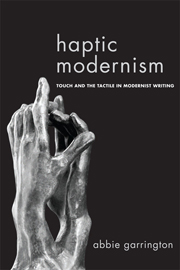Book contents
5 - D. H. Lawrence: Blind Touch in a Visual Culture
Published online by Cambridge University Press: 05 September 2013
Summary
The ‘Unimpeachable Kodak’
Alongside Aldous Huxley's imaginative exploration of the ‘feelies’, the work of D. H. Lawrence presents the most obvious opportunity to consider questions of touch and the tactile in modernist writing. So it is that, having considered Huxley in Chapter 1, we close with Lawrence. The latter offers a truly corporeal corpus, deeply invested in the experiences of the somatic system, and the philosophical and spiritual insight which consideration of the human body may bring. It is a catalogue of haptic material too vast to rehearse in detail here. Touch establishes male-to-male bonds in the oft-cited naked wrestling scene between Gerald Crich and Rupert Birkin of Women in Love (1920), in the bathing scene between George Sexton and Cyril Beardsall in The White Peacock (1911), and in Mellors's relationship with his former comrades in Lady Chatterley's Lover (1928). It creates betrothal in the story ‘Tickets, Please’, in ‘Hadrian [You Touched Me]’ and in ‘The Horse Dealer's Daughter’ (1922). In ‘Odour of Chrysanthemums’, a wife touches her dead husband in a belated gesture of care, while both care and spiritual symbolism are communicated by the woman who washes a young miner's feet in ‘Daughters of the Vicar’ (1914). The poems ‘Touch’, ‘Touch Comes’, ‘Noli me Tangere’ and ‘To Let Go or to Hold On’ announce their tactile concerns in their titles, but ‘Destiny’ also makes use of the customary hand metaphor (‘I wish you'd show your hand’ (Lawrence 1972: 430)), while ‘Know Deeply, Know Thyself More Deeply’ returns to the theme of darkness, and therefore touch, as a means of epistemological investigation.
- Type
- Chapter
- Information
- Haptic ModernismTouch and the Tactile in Modernist Writing, pp. 155 - 169Publisher: Edinburgh University PressPrint publication year: 2013



